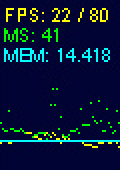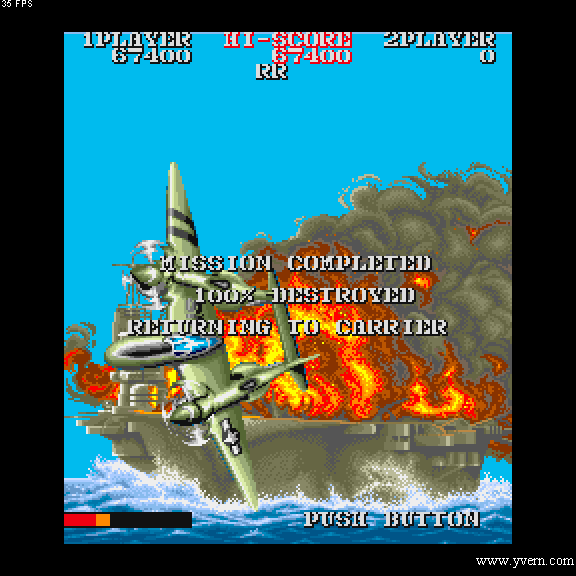Author Archive
-
Hi-Res – SWF performance stats with style
14th Aug 20080Ricardo Cabello released a really nifty stats tracker the other day. Just download the Stats.as file from his Google Code site, create the following folder structure: net / hires / utils and place the Stats.as file into that. Once done you can import the package into your own code and make use of it.
The end result? A beautiful little real-time performance display that looks like this:

The FPS gives you a current and maximum frame rate count (the maximum is derived from the stage frame rate setting). The MS is a micro-second counter. MEM is the total memory (in MB) your SWF is using.
The cute little graph below that is a historical visualisation of these three things, so you can watch for spikes / peaks during activity. You can click the top/bottom of the stats to increase/decrease the stage framerate.
Using it is as simple as adding one line of code:
All I’d say is remember to make sure this happens on the TOP of all of the rest of your display list items.
-
fMAME – It had to happen sooner or later :)
5th Aug 2008Over on yvern.com they’ve released the first version of fMAME – a Flash port of MAME, the Multiple Arcade Machine Emulator. It doesn’t have any sound support yet, and in the debug Flash player is a little slow, but it’s still a damned fine piece of work! Several older games are supported (1943, Hyper Sports, Galaga, etc) but it’s great to see this classic emulator ported to AS3.
Click the screenie to play.
Press the 5 key to insert a coin, arrow keys = movement, A = fire button 1, S = fire button 2.
-
Demo FX Lib
4th Aug 2008Somewhat inspired by my previous vectorball tests, and also from unearthing a load of my old demo source code, I decided to start porting some of the effects to AS3 into a single easy-to-use library, Demo FX Lib. Today I coded a nice image “drop down” effect, and a comprehensive 3D starfield routine. I’m very pleased with the starfield as it’s both smooth and versatile, you can literally tweak every value as it’s running, for some nice real-time effects.
The object of these effects is that you can literally pull them into your game as needed. None of them mess with the stage, all of them return (and work on) either a single bitmap or sprite, so can slot-in easily to an existing system. I want to add a classic scroll-text system, plasma and some other traditional effects before I release the library.
-
Morphing Shiny Balls
3rd Aug 2008I was messing around with a little of my old DarkBASIC code last Friday, and figured it would be fun to port it to AS3. I threw in some extra effects and a new shiny ball graphic and here is the end result of an hours work. Adding scaling and z-depth sorting was pretty easy. You do get quite a bit of “popping” because I only z-depth once per loop, but I can live with that 🙂
Adding a depth blur or hue shift is next on the list if I feel like it. There are 18 different wave forms in total. The SWF is 640×480 and published at 60fps (really meant for running on the desktop, but there we go)
[swfobj src=”http://sandbox.photonstorm.com/morph.swf” width=”640″ height=”480″]
-
The 8bitrocket 24-hour game challenge
22nd Jul 2008Over on 8bitrocket Jeff is going through the motions of creating a game in 24 hours (that’s just 24 man-hours.. not all spent at once) and is blogging about the process.
The game he has settled on is a loose remake of the Atari 2600 game Air-Sea Battle. In his first entry he’s spent an hour going over the different game types, how this could map to various levels within the game, and what his next steps will be.
I have to admit I found the post very interesting. Both from the point of view that I’d love to do something similar (a 24-hour game challenge for myself), and also because I think he’s spent too long on stage 1 🙂 Planning is crucial, no doubt about it, but I think the plan is far too complicated at the moment and has too many differing factors in there (game stages, different potential level designs, etc). So I’ll be curious to see how many items on his list actually make the final build, because 24-hours for a complete game with original non-ripped graphics (kudos to him for using them) is actually a very short time.
I also think because he is such an experienced programmer I bet it will take him a lot longer than say someone like Emanuele Feronato, who claims to create whole games in 45-minute plane trips (when you see the code, you appreciate why). I do wonder if Jeff will fall into the trap of wanting to make it sound on a code-design basis as well as game-design – and that takes precious time. Can’t wait to see how this plays out 🙂
Hire Us
All about Photon Storm and our
HTML5 game development services
Recent Posts
OurGames
Filter our Content
- ActionScript3
- Art
- Cool Links
- Demoscene
- Flash Game Dev Tips
- Game Development
- Gaming
- Geek Shopping
- HTML5
- In the Media
- Phaser
- Phaser 3
- Projects
Brain Food




